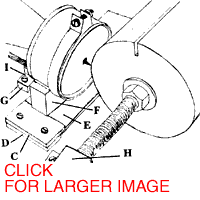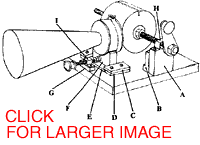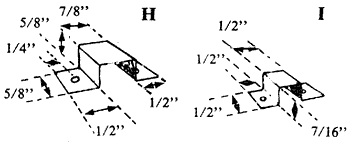


 NOTE: Diagrams have been added that may be helpful with construction. To save them, just right click on this link and choose "save target as". They are in PDF format so you will need the Adobe Acrobat Reader.
NOTE: Diagrams have been added that may be helpful with construction. To save them, just right click on this link and choose "save target as". They are in PDF format so you will need the Adobe Acrobat Reader.
There is also a PDF of the original, long out of print article.
This is based on an article written in 1977 by Donald W. Matteson, and published by the Edison Institute. It works much like Edison's original recorder, using metal foil to store the audio information. One piece 1/4" x 2" x 12" plywood and 1 piece 3/4" x 10" x 36" piece of clear white pine will provide enough wood for all pieces listed below. This is from an article which did not include metric measurements. I will add them as time allows. You will need:
Cut 4" circles from each of the 5 square wood pieces (it is MUCH better if you can glue the wood pieces and then turn them on a lathe - the truer the cylinder, the better). Drill 1/2" hole in center of each (the hole should be dead center). Glue together, keeping the hole free of glue. Once dry, cut 3/8" from one end of cylinder, so it is app. 3 3/8" long. Place nut and washer 3 3/4" from end of threaded shaft. Put cylinder on other end. Lock in place with second washer and nut. Make sure cylinder is as nearly perfectly round as possible. Cut a lengthwise slot on cylinder 1/8" deep x 3/32" wide.

Remove top and bottom of can. Cut down to app. 1 1/2". Cut mica or plastic to fit can opening, marking center w/compass. Epoxy to one end of can. Enlarge compass hole and screw in #4 screw for needle. Cover other end of can w/ circle of cardboard, which in turn has 3/4" hole cut in it. Make manila paper horn, 8" long, 4" one opening, 3/4" the other, and glue into hole in cardboard.
 Glue one A block to base, flush w/ one side of base (right side in the drawing) and 4 1/8" from front of base (2" side on base). Glue one block B to base and inside wall of A (2" side of B on base as well, so B is "L" shaped). Repeat on opposite side of base with other A & B so that the outsides of the "A" pieces are 8 11/16" apart (second "A" will not be flush with base side). All blocks should be 4 1/8" from front. Lay E on base. Lay F on E (2" side down) 9/16 from front of E and centered side to side. Hold can rim of RR (centered side to side) on front side of F so that the needle is 2 1/2" above the base. Trace position of can on F and cut out semi-circle. The RR can should fit the cradle in F. Glue F onto E, leaving 1/4" on each side and 9/16" on front. Clamp and dry.
Glue one A block to base, flush w/ one side of base (right side in the drawing) and 4 1/8" from front of base (2" side on base). Glue one block B to base and inside wall of A (2" side of B on base as well, so B is "L" shaped). Repeat on opposite side of base with other A & B so that the outsides of the "A" pieces are 8 11/16" apart (second "A" will not be flush with base side). All blocks should be 4 1/8" from front. Lay E on base. Lay F on E (2" side down) 9/16 from front of E and centered side to side. Hold can rim of RR (centered side to side) on front side of F so that the needle is 2 1/2" above the base. Trace position of can on F and cut out semi-circle. The RR can should fit the cradle in F. Glue F onto E, leaving 1/4" on each side and 9/16" on front. Clamp and dry.
 Place one D block 1" from front of base, 1 3/4" from flush support side of base. Place EF immediately to the left of D (touching) and place the other D block snugly against and to the immediate left of EF, 1" from front of base. Both D blocks should be parallel. Glue both D blocks into position. Add one C block to the top of D, flush w/ outside of D and overlapping EF base. Repeat on other side. Drill 2 holes each in C, 3/8" from outer edges and 3/8" from each end. Screw in #6 screws. Glue G to front edge of base, centered in front of EF. Slide on washer and screw 3 nuts halfway down 1/4" shaft. Rest final nut on G. Locate and drill 1/4" hole into F so that threaded shaft is parallel to base and perpendicular to EF when threaded through the hole. Place shaft through F and place washer and 2 nuts on the end that sticks through F. Outermost nut should be flush with end of shaft. Tighten inner nuts on either side of F, but not so tightly that shaft will not turn. Tighten outer 2 nuts against inner.
Place one D block 1" from front of base, 1 3/4" from flush support side of base. Place EF immediately to the left of D (touching) and place the other D block snugly against and to the immediate left of EF, 1" from front of base. Both D blocks should be parallel. Glue both D blocks into position. Add one C block to the top of D, flush w/ outside of D and overlapping EF base. Repeat on other side. Drill 2 holes each in C, 3/8" from outer edges and 3/8" from each end. Screw in #6 screws. Glue G to front edge of base, centered in front of EF. Slide on washer and screw 3 nuts halfway down 1/4" shaft. Rest final nut on G. Locate and drill 1/4" hole into F so that threaded shaft is parallel to base and perpendicular to EF when threaded through the hole. Place shaft through F and place washer and 2 nuts on the end that sticks through F. Outermost nut should be flush with end of shaft. Tighten inner nuts on either side of F, but not so tightly that shaft will not turn. Tighten outer 2 nuts against inner.
Place 1 nut on each end of the 1/2" shaft. Put shaft and cylinder on A blocks so the nuts rest on the A blocks. Take H and bend as shown (make 2); do the same with I (only one). Drill holes in the center of both tabs of H and I to accept screws. Put H braces over nuts in cylinder shaft on both A blocks. Screw down. Nuts should not move. Attach I to G in same manner, placing bracket over 1/4" nut resting on G. Put a drawer knob on the end of the 1/4" shaft. A hand crank will need be designed for the end of the cylinder shaft, using sheet metal, nuts, and a drawer knob. Mount RR to E/F assembly using epoxy or a sheet metal bracket of your own design. Cut felt to fit cylinder, leaving slot open, and glue in place.

Cut a sheet of tinfoil 3 to 3 1/4" wide by 13" long. Put one end in the slot of the cylinder and wrap, smoothing as you go. Put loose end in slot and secure with part of a wire coat hanger or cardboard wedge. The foil should be tight and smooth. Turn the crank to move the cylinder all the way to one end. Turn the RR screw until the needle just touches the foil. Turn the crank and adjust until the needle begins to form a slight groove on the foil. The crank should be turned at a uniform speed (65-70 rpm is the ideal, moving the cylinder the length of the shaft in about 30 seconds). You will want to practice so you can record and play back at the same speed. When recording, speak in a very loud and clear voice into the horn (you may need to shout).
After recording, back the RR needle away from the foil. Rewind the cylinder to its original position. Advance the needle so it is not quite so deep as for the recording and turn the crank at the same rate as before. You should hear what was recorded through the horn. Adjustments are critical, since the foil can be torn or the recording erased very easily. It will take much trial and error to use it expertly.
Here is a wav file of Edison's recording on the phonograph. The original recording was made in 1877 (there is no recording available of this); this one was made on a similar machine by Edison in 1927 to mark the 50th anniversary.
Aluminum foil really is not the thing for this. It will likely tear, makes a noisy recording and was too expensive in Edison's day anyway. You really need tin. To read more about it, check out this aticle on René Rondeau's Antique Phonograph Gallery pages. He also has written a book on the subject!
Matt Langille, of Nova Scotia, Canada, wrote to contribute the following tips:
"We built your phonograph for a science project. We made it work after many difficulties. Here are a few ideas that may help others:
Thanks, Matt!
Almost every problem reported had something to do with the recorder/reproducer head. The R/R needs to be firmly mounted to the EF block assembly so that it doesn't slide around. The diaphragm needs to be made of a material rigid enough to vibrate, but not too rigid (Matt Langille's suggestion of a CD cover works nicely). And the needle needs to be adjusted carefully so that it makes a groove in the foil while recording without tearing the foil. It should contact the foil somewhat lighter when reproducing the sound. You will only get this right by much trial and error.
Tinfoil Phonographs by René Rondeau. A wonderful book on the tinfoil phonograph, very well researched, and with many excellent illustrations. Also includes another plan for building a phonograph! .

This article was printed from the Bizarre Labs website at bizarrelabs.com